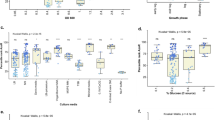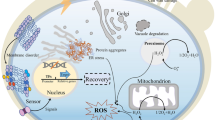Abstract
Oxidative stress is an unavoidable consequence of interactions with various reactive oxygen species (ROS)-inducing agents that would damage cells or even cause cell death. Bacteria have developed defensive systems, including induction of stress-sensing proteins and detoxification enzymes, to handle oxidative stress. Cyclic diguanylate (c-di-GMP) is a ubiquitous intracellular bacterial second messenger that coordinates diverse aspects of bacterial growth and behavior. In this study, we revealed a mechanism by which c-di-GMP regulated bacterial oxidative stress resistance in Pseudomonas putida KT2440. High c-di-GMP level was found to enhance bacterial resistance towards hydrogen peroxide. Transcription assay showed that expression of two oxidative stress resistance genes, fpr-1 and katE, was promoted under high c-di-GMP level. Deletion of fpr-1 and katE both decreased bacterial tolerance to hydrogen peroxide and weakened the effect of c-di-GMP on oxidative stress resistance. The promoted expression of fpr-1 under high c-di-GMP level was caused by increased cellular ROS via a transcriptional regulator FinR. We further demonstrated that the influence of high c-di-GMP on cellular ROS depend on the existence of FleQ, a transcriptional regulatory c-di-GMP effector. Besides, the regulation of katE by c-di-GMP was also FleQ dependent in an indirect way. Our results proved a connection between c-di-GMP and oxidative stress resistance and revealed a mechanism by which c-di-GMP regulated expression of fpr-1 and katE in P. putida KT2440.






Similar content being viewed by others
References
Abella M, Rodriguez S, Paytubi S, Campoy S, White MF, Barbé J (2007) The Sulfolobus solfataricus radA paralogue sso0777 is DNA damage inducible and positively regulated by the Sta1 protein. Nucleic Acids Res 35:6788–6797
Bojanovič K, D'Arrigo I, Long KS (2017) Global transcriptional responses to osmotic, oxidative, and imipenem stress conditions in Pseudomonas putida. Appl Environ Microbiol 83:e03236–e03216
Boonma S, Romsang A, Duang-Nkern J, Atichartpongkul S, Trinachartvanit W, Vattanaviboon P, Mongkolsuk S (2017) The FinR-regulated essential gene fprA, encoding ferredoxin NADP+ reductase: roles in superoxide-mediated stress protection and virulence of Pseudomonas aeruginosa. PLoS One 12:e0172071
Cho JH, Kim EK, So JS (1995) Improved transformation of Pseudomonas putida KT2440 by electroporation. Biotechnol Tech 9:41–44
Chua SL, Ding Y, Liu Y, Cai Z, Zhou J, Swarup S, Drautz-Moses DI, Schuster SC, Kjelleberg S, Givskov M (2016) Reactive oxygen species drive evolution of pro-biofilm variants in pathogens by modulating cyclic-di-GMP levels. Open Biol 6:160–162
Dos Santos VA, Heim S, Moore ER, Strätz M, Timmis KN (2004) Insights into the genomic basis of niche specificity of Pseudomonas putida KT2440. Environ Microbiol 6:1264–1286
Farr SB, Kogoma T (1991) Oxidative stress responses in Escherichia coli and Salmonella typhimurium. Microbiol Rev 55:561–585
Hickman JW, Harwood CS (2008) Identification of FleQ from Pseudomonas aeruginosa as a c-di-GMP-responsive transcription factor. Mol Microbiol 69:376–389
Hisert KB, MacCoss M, Shiloh MU, Darwin KH, Singh S, Jones RA, Ehrt S, Zhang Z, Gaffney BL, Gandotra S, Holden D, Murray D, Nathan C (2005) A glutamate-alanine-leucine (EAL) domain protein of Salmonella controls bacterial survival in mice, antioxidant defence and killing of macrophages: role of cyclic diGMP. Mol Microbiol 56:1234–1245
Huang CJ, Wang ZC, Huang HY, Huang HD, Peng HL (2013) YjcC, a c-di-GMP phosphodiesterase protein, regulates the oxidative stress response and virulence of Klebsiella pneumoniae CG43. PLoS One 8:e66740
Imlay JA (2013) The molecular mechanisms and physiological consequences of oxidative stress: lessons from a model bacterium. Nat Rev Microbiol 11:443–454
Jenal U, Reinders A, Lori C (2017) Cyclic di-GMP: second messenger extraordinaire. Nat Rev Microbiol 15:271–284
Kim J, Park W (2014) Oxidative stress response in Pseudomonas putida. Appl Microbiol Biotechnol 98:6933–6946
Kim YC, Miller CD, Anderson AJ (1999) Transcriptional regulation by iron of genes encoding iron- and manganese-superoxide dismutases from Pseudomonas putida. Gene 239:129–135
Lacey MM, Partridge JD, Green J (2010) Escherichia coli K-12 YfgF is an anaerobic cyclic di-GMP phosphodiesterase with roles in cell surface remodelling and the oxidative stress response. Microbiology 156:2873–2886
Lee Y, Peña-Llopis S, Kang YS, Shin HD, Demple B, Madsen EL, Jeon CO, Park W (2006) Expression analysis of the fpr (ferredoxin-NADP+ reductase) gene in Pseudomonas putida KT2440. Biochem Biophys Res Commun 339:1246–1254
Levanon S, San K, Bennett G (2010) Effect of oxygen on the Escherichia coli ArcA and FNR regulation systems and metabolic responses. Biotechnol Bioeng 89:556–564
Li W, Hu L, Xie Z, Xu H, Li M, Cui T, He ZG (2018a) Cyclic di-GMP integrates functionally divergent transcription factors into a regulation pathway for antioxidant defense. Nucleic Acids Res 46:7270–7283
Li W, Li M, Hu L, Zhu J, Xie Z, Chen J, He ZG (2018b) HpoR, a novel c-di-GMP effective transcription factor, links the second messenger’s regulatory function to the mycobacterial antioxidant defense. Nucleic Acids Res 46:3595–3611
Loewen PC, Switala J, Triggs-Raine BL (1985) Catalases HPI and HPII in Escherichia coli are induced independently. Arch Biochem Biophys 243:144–149
Lushchak VI (2011) Adaptive response to oxidative stress: bacteria, fungi, plants and animals. Comp Biochem Physiol C Toxicol Pharmacol 153:175–190
Martin CH, Wu D, Prather KL (2010) Integrated bioprocessing for the pH-dependent production of 4-valerolactone from levulinate in Pseudomonas putida KT2440. Appl Environ Microbiol 76:417–424
Merighi M, Lee VT, Hyodo M, Hayakawa Y, Lory S (2007) The second messenger bis-(3′-5′)-cyclic-GMP and its PilZ domain-containing receptor Alg44 are required for alginate biosynthesis in Pseudomonas aeruginosa. Mol Microbiol 65:876–895
Nelson KE, Weinel C, Paulsen IT, Dodson RJ, Hilbert H, Martins Dos Santos VA, Fouts DE, Gill SR, Pop M, Holmes M (2003) Complete genome sequence and comparative analysis of the metabolically versatile Pseudomonas putida KT2440. Environ Microbiol 4:799–808
Newell PD, Monds RD, O'Toole GA (2009) LapD is a bis-(3',5')-cyclic dimeric GMP-binding protein that regulates surface attachment by Pseudomonas fluorescens Pf0-1. Proc Natl Acad Sci U S A 106:3461–3466
Nikel PI, de Lorenzo V (2013) Implantation of unmarked regulatory and metabolic modules in Gram-negative bacteria with specialised mini-transposon delivery vectors. J Biotechnol 163:143–154
Paul K, Nieto V, Carlquist WC, Blair DF, Harshey RM (2010) The c-di-GMP binding protein YcgR controls flagellar motor direction and speed to affect chemotaxis by a "backstop brake" mechanism. Mol Cell 38:128–139
Poblete-Castro I, Becker J, Dohnt K, dos Santos VM, Wittmann C (2012) Industrial biotechnology of Pseudomonas putida and related species. Appl Microbiol Biotechnol 93:2279–2290
Puchałka J, Oberhardt MA, Godinho M, Bielecka A, Regenhardt D, Timmis K, Papin JA, Martins dos Santos VAP (2008) Genome-scale reconstruction and analysis of the Pseudomonas putida KT2440 metabolic network facilitates applications in biotechnology. PLoS Comput Biol 4:e1000210
Semchyshyn H, Bagnyukova T, Storey K, Lushchak V (2005) Hydrogen peroxide increases the activities of soxRS regulon enzymes and the levels of oxidized proteins and lipids in Escherichia coli. Cell Biol Int 29:898–902
Smith PK, Krohn RI, Hermanson GT (1985) Measurement of protein using bicinchoninic acid. Anal Biochem 163:76–85
Spangler C, Böhm A, Jenal U, Seifert R, Kaever V (2010) A liquid chromatography coupled tandem mass spectrometry method for quantitation of cyclic di-guanosine monophosphate. J Microbiol Methods 81:226–231
Tammariello SP, Quinn MT, Estus S (2000) NADPH oxidase contributes directly to oxidative stress and apoptosis in nerve growth factor-deprived sympathetic neurons. J Neurosci 20:RC53
Tanaka K, Handel K, Loewen PC, Takahashi H (1997) Identification and analysis of the rpoS-dependent promoter of katE, encoding catalase HPII in Escherichia coli. Biochim Biophys Acta 1352:161–166
Timmis KN (2002) Pseudomonas putida: a cosmopolitan opportunist par excellence. Environ Microbiol 4:779–781
Ude S, Arnold D, Moon CD, Timms-Wilson T, Spiers AJ (2006) Biofilm formation and cellulose expression among diverse environmental Pseudomonas isolates. Environ Microbiol 8:1997–2011
Vlamakis H, Aguilar C, Losick R, Kolter R (2008) Control of cell fate by the formation of an architecturally complex bacterial community. Genes Dev 22:945–953
Weinhouse H, Sapir S, Amikam D, Shilo Y, Volman G, Ohana P, Benziman M (1997) C-di-GMP-binding protein, a new factor regulating cellulose synthesis in Acetobacter xylinum. FEBS Lett 416:207–211
Xiao Y, Nie H, Liu H, Luo X, Chen W, Huang Q (2016) C-di-GMP regulates the expression of lapA and bcs operons via FleQ in Pseudomonas putida KT2440. Environ Microbiol Rep 8:659–666
Yeom J, Imlay JA, Park W (2010a) Iron homeostasis affects antibiotic-mediated cell death in Pseudomonas species. J Biol Chem 285:22689–22695
Yeom S, Yeom J, Park W (2010b) Molecular characterization of FinR, a novel redox-sensing transcriptional regulator in Pseudomonas putida KT2440. Microbiology 156:1487–1496
Yeom J, Lee Y, Park W (2012) ATP-dependent RecG helicase is required for the transcriptional regulator OxyR function in Pseudomonas species. J Biol Chem 287:24492–24504
Zheng M, Doan B, Schneider TD, Storz G (1999) OxyR and SoxRS regulation of fur. J Bacteriol 181:4639–4643
Funding
The research was financially supported by The National Key Research and Development Program of China (2016YFD0800206), the National Natural Science Foundation of China (41571230), and The China Postdoctoral Science Foundation (2018M642861).
Author information
Authors and Affiliations
Corresponding authors
Ethics declarations
This article does not contain any studies with human participants or animals performed by any of the authors.
Conflict of interest
The authors declare that they have no conflict of interest.
Additional information
Publisher’s note
Springer Nature remains neutral with regard to jurisdictional claims in published maps and institutional affiliations.
Rights and permissions
About this article
Cite this article
Xiao, Y., Zhu, W., He, M. et al. High c-di-GMP promotes expression of fpr-1 and katE involved in oxidative stress resistance in Pseudomonas putida KT2440. Appl Microbiol Biotechnol 103, 9077–9089 (2019). https://doi.org/10.1007/s00253-019-10178-6
Received:
Revised:
Accepted:
Published:
Issue Date:
DOI: https://doi.org/10.1007/s00253-019-10178-6




